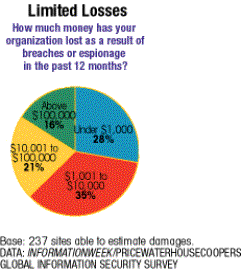 In
the digital economy, security breaches are inevitable. Organizations rushing to
build information systems for all forms of digital commerce are realizing
there's no fail-safe way to secure the free flow of data or money. Except it's
often far worse. Organizations engaged in Web commerce, electronic supply
chains, and enterprise resource planning experience three times the incidents
of information loss and theft of trade secrets than everybody else. The digital
commerce sites experiencing the most attacks, including banks and financial
services companies, are the same disciplined IT shops that also create
information security policies, spend lots of money on security products such as
firewalls and encryption, and institute policy training for IT staff and end
users.
In
the digital economy, security breaches are inevitable. Organizations rushing to
build information systems for all forms of digital commerce are realizing
there's no fail-safe way to secure the free flow of data or money. Except it's
often far worse. Organizations engaged in Web commerce, electronic supply
chains, and enterprise resource planning experience three times the incidents
of information loss and theft of trade secrets than everybody else. The digital
commerce sites experiencing the most attacks, including banks and financial
services companies, are the same disciplined IT shops that also create
information security policies, spend lots of money on security products such as
firewalls and encryption, and institute policy training for IT staff and end
users.
As indicated by the graph to the left,
these security breeches are costing corporations money, and sometimes lots of
it. Often times, the companies are not even aware of it. In a recent survey of
1600 IT and security professionals in 500 countries, 49% concede they don't
know if they were pickpocketed in the past year. Only 28% say they're certain
they haven't suffered any monetary loss. The expectation is that as electronic
commerce revenues grow, so will the losses due to security breeches. Obviously,
there is enough at risk for corporations to be motivated to protect their
information systems.
There are many tools available
corporations can use to safeguard their information systems. Our project has
chosen only a few of them. Click on the links above for more information on
each:
* Graph and content of the above introduction taken
from Information Week's August 31, 1998 article "Acceptable Risks"
located at http://www.informationweek.com/698/98iursk.htm.
Rich Aliano
Dominick Diorio
Tom Holleman
Paul Palicki
Cathy Malabunga

Last changed: March 18, 1999